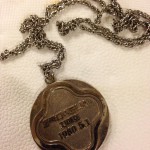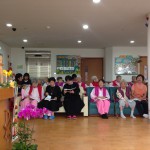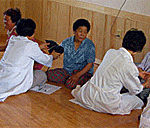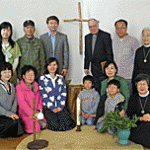Korea: Diakonia Sisterhood in South Korea
Name: Diakonia Sisterhood in Korea
When was it established? The Protestant women’s diakonia community was formed on May 1, 1980, and is associated with Kaiserswerther Verband (Germany).
Number: 2016 – 9 sisters (and 14 Diakonia Secular Institute members)
Title: Sister
Key personnel: Sr. Young-Sook Ree (Oberin), Director of Diakonia Sisterhood in Korea
Location: In 2016, the motherhouse was moved from CheonAn to Mokpo with a new centre officially opened on May 1st, 2016. Cheon-An had offered a spiritual retreat centre as well as the site of the motherhouse. The new centre is located near the sea and mountains providing a place of healing and prayer for the public as well as a home for the members of our Sisterhood, who live in community together.
Theological framework: the Sisters cite The Good Samaritan as an important text – go out and find the needy people and care for them.
Distinctive clothing
The sisters wear a simple ‘habit’ and a silver medallion. On one side is the date the sisterhood was founded (1 May, 1980), and on the other side is a logo. It is round, like the earth. It has a fluid cross (not a ‘Roman’ fixed cross) and in the centre is the small lamp typical in Korea – a symbol of the light of the world and the warmth of care).
Membership:
Diakonia Korea is small. Sister Pak, a newer member says she was attracted to it because she loved the spirit of Diakonia Korea, and wanted to devote herself in service to others. She says, ‘I wanted to live like Jesus, but couldn’t do it on my own. But we can do it together as a community of sisters’.
Church connection:
Each sister has their own affiliation or membership with an established Protestant denomination, but Diakonia Korea itself is not affiliated with a denomination.
Community:
The sisters live in community and have daily practices including worship in the morning and at night in their simple chapel. They have a day off a month to refresh, and a week off a year for recreation.
History
A single, female, Christian doctor (Dr Sook) had been working closely with TB patients and was a close friend of the founder of a new community of Diaconal sisters, Dr. Byeong-Mu Ahn who was instrumental in establishing the sisterhood in Korea. They shared a similar sense of spirituality. The doctor donated the land and the buildings on the property at donation the diaconal sisters who were also working with TB patients, considered to be among Korea’s most alienated people. Many of the sisters were nursing sisters and were able to assist with medical needs. They served the people dearly, taking care of them as friends when even their own families feared coming near. The doctor also donated land at Cheon-an. She was a generous benefactor whose legacy has provided the sisters with the opportunity to provide effective ministry.
As the Republic of Korea became more prosperous, the government took over much of the tuberculosis work but the sisters continued to serve those whom rising prosperity has left behind, particularly the aged and the homeless.
They expanded their care to other needy people in the island area, especially in the area of preventative care. They began visiting the homes in the area, one by one. They discovered the depth of poverty for poor farming families, and that the children were not able to attend school because they parents could not pay the tuition fee. This was at a time when there was almost no government help, and it was just the beginning of social welfare provisions.
To enable the children to access schooling and oversee a scholarship fund for students whose parents are disabled or who are themselves family breadwinners. Funds are raised from the supporting members of the Diakonia sisterhood.
The farmers’ perilous financial situation led to many suicides. In response, the sisters set up a credit bank and offered micro-finance low interest loans.
The sisters also arranged for the installation of purpose built facilities for older people. For instance, in cases where the elderly were not able to access bathing facilities due to limited mobility.
They began an education program, identifying young people and community elders who could take on the roles the sisters had been undertaking. In basic preventative health, the women in the community were taught to monitor blood sugar levels for diabetes patients, blood pressure etc. There was no hospital in the area, so this preventative medical procedures were especially important.
The sisters also asked for help from Chunum University which had a nursing department, in which some of the Diaconal sisters had received their training.
In 1991, the sisters handed everything over to the farming community. They did so, guided by their discernment about future priorities God was leading them towards, and also by the philosophy of the Chinese philosopher Noja – if you achieve, leave with empty hands. Professor Eun-young Ahn particularly emphasized this attitude. The sisters also saw that the village people and farming community were now able to stand by themselves but that nothing had been happening for the poor in Mok-po, so they moved their attention to this area close to Mok-po harbour.
For the first year, the sisters simply lived amongst the people – greeting the locals, and doing simple tasks of service such as cleaning the roads. In the second year, they began to go from house to house, asking what needs the people have. From there, the sisters found ways to respond to the needs of the poor people in the area. TB was a problem, which the sisters were able to help with given that some had a nursing background. They assisted the people with gaining some basic skills whereby they could gain employment – driving for the men, craft work for the women. In time, they were able to live together as a community and to survive on their own. Once again, the sisters gave all they had developed to the community and left to begin a new phase in ministry.
The TB patients may have been cured but they had nowhere to live as they had no home to go back to and families did not always welcome them into their homes. This was a particular issue for ageing people. The sisters developed an aged care facility on the current location in Muan, near Mok-po – the Diakonia Residential Home for the Elderly Nursing Home, which was completed in July 2008 and opened officially in 2009. It is part of the Social Welfare Corporation of Diakonia Sisterhood Korea. The facility can provide medical and spiritual services for up to 50 individuals.
The Sisters also responded to the concern of ageing people about what will happen to their bodies when they die – where can we be laid to rest? The sisters are trained to do all the work of the mortician and undertaker, lovingly preparing the body of a deceased person for the funeral and burial. The knowledge that they will be taken care of, even in death, has granted a sense of peace to the older people, and offers them dignity in death. The sisters established a hospice system at a time when there was no concept of hospice in the wider community. They are able to care for living, and to help people prepare for death with dignity, surrounded by love and care. They attend to people’s spiritual needs as they prepare for death, including dealing with unresolved issues in their lives and with forgiveness with family and friends. They encourage people to be organ donors when they die, to give a gift that enables others to live their lives more fully. Each of the sisters are registered organ donors.
In 1996, the sisters were invited by Mokpo City to provide assistance to a feeding program located in front of the train station, with a free lunchtime cafeteria. The City provided funding to feed 50 people, and the sisters involved many churches in helping to prepare food each day. Ecumenical cooperation is not typical, so it is remarkable that this program developed as it did. The sisters were the centre of churches working together. The program was recognised as a model throughout Korea. In 1997, numbers grew with the financial depression, and numbers contined to increase. The sisters provided leadership for the program until 2005, and advised the Mok-po City that they would be handing it over to another organization to coordinate. Their decision was again guided by the Chinese philosopher Noja – if you achieve, leave with empty hands.
The sisters wanted to give priority to the program at the motherhouse with aged care. They also realised that they could not continue to ‘do’ without being spiritually nourished. They describe it as their spirit being placed in jeopardy. If they are not spiritually strong, they cannot influence or give leadership. They decided to create a centre for spirituality at Cheon-an, with some of the sisters remaining in Muan, Mok-po, and some basing themselves at Cheon-an. In the future, the sisters hope there can be more rotation of the sisters between the two centres, so all sisters can be involved in both ministry areas. Mok-po remains the main centre.
The spirituality centre, House of Spirituality and Peace, has developed ecumenical retreat and prayer programs for churches and individuals, so together, the two locations are resourcing the ‘poor in spirit’ as well as those who are poor and disadvantaged. The centre offers prayer, contemplation and meditation, which is new to Protestants in Korea. In the beginning, some churches rejected it, perhaps because it had aspects that might be seen as Buddhist rather than Christian, but now some churches are taking up the opportunity for these spiritual practices.
Under the Household Support Project, the Sisters have visited impoverished houses in five villages around Sam-Hyang, providing counselling and various medical services including acupuncture and pressure point masage. In 2009, around 1,094 people received this service.
The Sisters also provide a Rural Household Rehabilitation programme, and in one year helped about 20 households to insulate and repair roofs and windows, and to install new boilers. The Sisters also visit elderly people living alone, children without parents, and those who cannot work due to disability around the district of Muan and help them with living costs, medical expenses and school frees. There are about 30 students who receive full scholarships each year. This includes food and study materials as well as private tuitions and counselling services. The students also participate in the services for the elderly or the disabled, teaching the students to learn the joy of serving one’s neighbours.
Current focus
The aged care and spiritual centre continue, but there are ongoing and emerging social-cultural, ecological and economic issues in the Muan-gun area where the sisters are working and serving. The rural area had been identified as a potential ‘enterprise city’ with an international industrial complex. But this scheme has failed to be realized, in part due to the Global Financial Crisis of 2008, economic recession, and a reluctance to invest in underdeveloped areas. However, the concept of the enterprise city meant land prices soared with increasing rents for agricultural lands so small farmers face increasing financial challenges. This has led to an increasing divorce rate, domestic violence, and runaways from home to larger cities where people hope for a change in their personal economic circumstances. The impact of poverty significantly impacts women and children. An emerging issue is the role if grandparents in being a primary caregiver for children if divorced couples, including those in the city who send their children to rural areas to be cared for by extended family, and especially grandparents. In one instance, a grandmother is primary caregiver for 5 children from her three sons.
The number of families of North Korean defectors has been gradually increasing in the Muan area. The sisters are responding to some of the needs, to help overcome the crisis if family disorganization, and offering personalized services such as livelihood support, medical support, and family counselling, and, in co-operation with community agencies, seek to offer financial, health, psychological and emotional support.
The Diakonia scholarship program for the children continues, and offers a positive way for children to complete high school education. As well, the program offers economic support and mediation services, to solve the dual problems with ageing and of grandparents’ parenting burden of their grandchildren.
Funding
Some funding comes from partners such as Chodang University (Muan-gun), and DOAM (Deutsch Ostasienmission) and support from Kaiserswerther Verband (Germany)
German sponsors visiting with Korean deaconesses
Training and formation
Some sisters have nursing training and others are social workers. Some have undertaken theological training. There is no institutional training requirements as Diakonia Korea is not affiliated with a particular denomination.
Every month on the third and fourth week, Spiritual Leadership Meetings are held for Diakonia Family Members and other individuals who wish to lead the life of Diakonia.
Ecumenical and interfaith relations
The sisters participate in ‘Sam Soh Hui’ – an interdenominational network of Protestant, Catholic, Anglican, Buddhist and Won Buddhist female monks.
Key issues and challenges in the contemporary ministry context
In recent years, increased tension between North and South Korea has led to increased military spending but decreased welfare spending by South Korean government. As a result, supports to the social and welfare programmes also decreased a great deal.
Newsletter 2010 link
Newsletter 2016 anhang-diakonia-sisterhood-in-korea-englisch.
(updates or edits to Rev Sandy Boyce, President, DIAKONIA World Federation, sandyeboyce@gmail.com)






